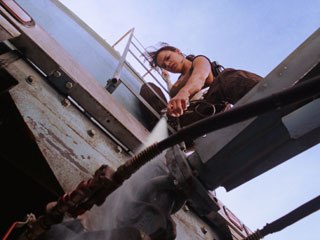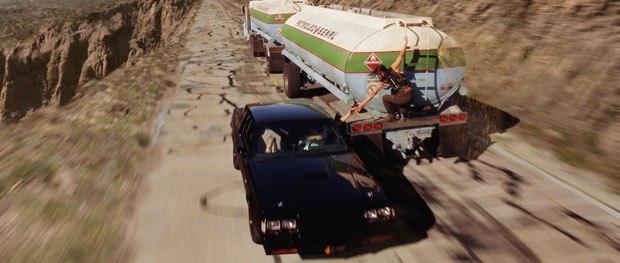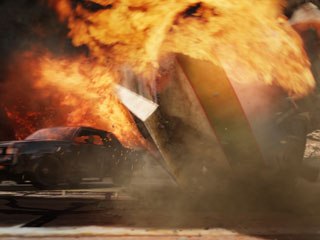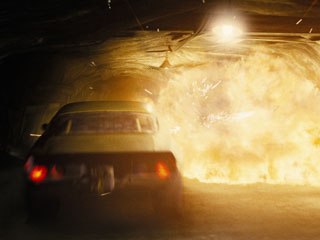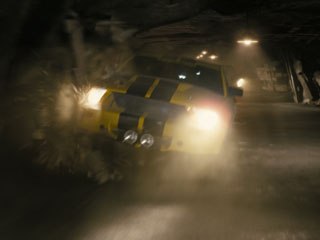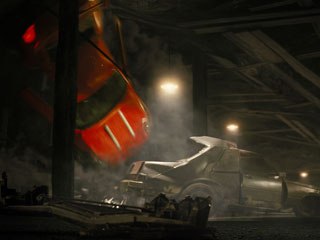Tara Bennett looks under the hood of the fourth Fast & Furious car movie to find out what Rhythm & Hues and Double Negative tricked out.
By the looks of it, audiences really missed the pedal to the metal, nitrous-powered fun created through The Fast and the Furious film franchise. The third sequel in the series, Fast & Furious, reunited the entire original cast, including Vin Diesel, Paul Walker, Jordana Brewster and Michelle Rodriguez for an amped-up event movie that debuted with an astounding domestic box office take of $70.95 million last weekend. Obviously director Justin Lin (The Fast and the Furious: Tokyo Drift) found the right balance of cars, characters and eye-popping visuals that translated into box office supremacy.
And in achieving those visuals that couldn't be created practically, Lin went to some of the best vfx houses to craft sequences that pushed the limits of what the franchise has been able to achieve on film. Visual Effects Supervisor, Michael J. Wassel, a veteran of all previous Fast films, commissioned more than eight separate vendors to create elements or sequences for the film. VFXWorld spoke with two: Rhythm & Hues Studios and Double Negative (dNeg) about what they were able to achieve.
Rhythm & Hues Studios: Flaming Trucks
Bob Mercier, visual effects supervisor for Rhythm & Hues Studios, was hired to blow audiences away with a death-defying flaming truck sequence featuring hijackers Diesel and Rodriguez. He explains, "The main technical challenge was to recreate the environment that the action takes place in because the second half of the sequence is entirely synthetic and is modeled after geography that has the flavor of the Dominican Republic but was completely designed by the production.
"The director was after a very specific and treacherous look to the environment," Mercier explains about the two minute-plus set piece. "He wanted the feeling of a runaway vehicle on a very steep downhill grade with absolutely no way for Vin Diesel and Michelle Rodriguez's vehicle to escape. There had to be no way to pull off and nowhere to pull to the side of the road while the tanker flies by them, so it was a very specific design.
"We started with our art department doing concept paintings. We went back and forth with the director for several weeks. Once we had some approval, part of the original shoot took place near the grapevine off the 5 [freeway] near Pyramid Lake in California. We went to that area and took hundreds of reference photos so we could match the look of the vegetation and rocks from early in the sequence. Later in the sequence we are in a deeper rocky ravine, so we looked everywhere we could within several hours of Los Angeles for the right kind of texture reference. We ended up shooting rock faces off the Pacific Coast Highway just south of Oxnard. We used all of that texture reference together and built a 3D model of the environment and section by section, we texture mapped using projection textures."
Describing the projection process, he details, "We would have between eight and 15 cameras to project the images for each shot. There was the primary camera that we looked through, but to get the textures onto the geometry would require a series of projection cameras."
The next challenge for R&H was the dramatic rollover by the tanker. "In the second half of the opening sequence, the hero tanker flips over and bursts into flames and rolls end-over-end towards a cliff, creating a situation that Vin has to get out of. The rolling tanker, the fire, the smoke and all its interaction with the environment is all-CG at that point. So the other major challenge of the sequence was the CG tanker and volumetric fluid simulations for the smoke and integrating a combination of CG fire and photographed fire. All of that together took the next five months.
"It's still very difficult for anyone in the effects industry, from ILM to us, to create absolutely realistic CG fire. We relied on a lot of practical fire elements that were shot but we integrated those with our CG smoke -- marrying the two together seamlessly was the greatest challenge. We used a combination of Houdini and our own tools for the fluid simulations. We pushed our fluid simulation tools harder than we ever have. We've obviously done good water in the past, but repurposing those same tools to do fluid dynamics to this degree was a first for us."
Allowed to tweak the process over a span of several months, Mercier says they strongly advanced their in-house R&H fire effects skill set. "We certainly feel like we understand this process very, very well now and in the future we would have better ideas for how to shoot pyro elements specifically for this purpose. Our wish is that we continue to develop our fire rendering technology so it will be believable enough and stand up to the entire effect being computer-generated. That's the Holy Grail! It is a big mandate for us. We continue to try and pursue it all the time. This industry goes through phases: people do volumetrics and effects with water and then effects with Massive for armies. Things seem to go through waves and one of the big, open things is very high quality fire."
With audiences floored by the opening sequence, Mercier says he's proud of R&H's part in revitalizing the franchise. "We're very happy with it as it's a very exciting way to open the film. It has a little bit of a Bond film feel, opening with a heavy action sequence. It's a great way to reintroduce the characters, people we haven't seen [in awhile] like Michelle, and then it sets the tone for the entire rest of the movie."
Double Negative: Road Tunnel Chases
Double Negative's VFX Supervisor, Frazer Churchill, who was busy with his next project, provided some notes about their work on Fast & Furious. The team, which included VFX Producer Moriah Etherinton-Sparks, CG supervisor Jordan Kirk, 2D Supervisor Jon Bowen, FX supervisor Alexander Seaman and Matchmove Supervisor Andrew Tulloch, completed 270 shots for the movie.
Primarily, Churchill's group worked on a sequence that featured a chase through a warren of road tunnels used by ruthless drug smugglers. Diesel and Walker's characters have infiltrated the drug gang and in dNeg's first sequence, the duo is being led through a tunnel as they are trying to memorize the way.
"Car chases in abandoned mine shafts are not easy to come up with!" Churchill explains. "There are no abandoned mine shafts where you can film this kind of thing, so an environment was needed. As you would expect, the cars are the real stars of the film, so rather than do the whole sequence in CG it was decided to shoot the cars as live action and simulate the tunnel environment needed around them, so the entire environment was re-created in CG."
Production created a series of "tunnels" in a mile-long stretch of empty shipping containers at the Port of Los Angeles that were wrapped in beige fabric to achieve a neutral lighting. "Greenscreen would have caused so many spill problems that it would have really affected the way that the work was done," Churchill adds. "Beige was ok to use as the team were not going to use keying to track the cars. Instead all of the cars were covered in LEDs and the tunnel was also covered in LEDs so they were all able to be pin-pointed." Churchill explains the cars were also "cyber-scanned" to create accurate mattes.
Churchill continues that the production art department built set dressing for parts of the tunnel, allowing the cars to react to the environment. "Our job at that stage was to try to work with the production and help them envisage what it was going to look like when finished. We needed to make sure all the pieces would work within the constraints of a CG environment and the cast and crew needed to be aware of the layout, taking care to avoid the CG environment that hadn't been built yet.
"There were some amazing stunts captured in [the tunnel]. All the car stunts were executed by Terry Leonard. Cars jumping over ramps in tunnel, cars flipping end over end in the tunnel... truly amazing.
"Back at Double Negative, CG supervisor Jordan Kirk and his team were busy creating an environment of tunnels. There were three types: two miner tunnels (a single wide and a double wide), and one smuggler's tunnel. The tunnel environment created at the L.A. port had to be replaced with a tighter more confined layout, and this called for a fully CG environment."
Each of the layouts was hand-sculpted with procedural tools, but they lacked the randomness of reality. The team referenced photographs from quarries in mines local to the London studio and visited Chislehurst in Kent to take reference photos and HDRI tiles to sample the lighting. Ultimately, the environment was lit and rendered out with this HDRI environment information, which was then used for textures, re-projection and also used in the modeling and reference for the sculpting. The team used Double Negative's proprietary software Photofit and Stig for the re-projection and Photofit was also used to aid modeling. The build took two months in total, with a team of 10 artists, modeling and texturing -- when they had finished, 2 to 3,000 feet of digital tunnel had been created. All of which had to be dressed with CG props, such as wooden arches, struts, wall cladding, chains, pulleys, buckets, wheelbarrows, debris, smoke and dust. In addition, there were many shots that required bespoke setups, so new environments had to be developed on the fly as requested. As the action literally bursts through from the tunnels out into daylight, the mountain exteriors were mostly matte paintings -- re-projected onto 3D geometry.
The dNeg team also focused on the realistic movement of the cars. "Since the cars had been filmed in a very restricted environment -- cars driving safely at 20 mph in the alleyway -- the main issue was to make it look like the cars were going very fast in very small alleyways. There wasn't much scope in 2D to re-time the cars without them looking like toy cars, so a key factor to the work was environment re-speeds. The team had to track cars at normal speed, using markers that had been placed on the cars and walls. In the unlit tunnels the team used the 3D render as a matte for the cars. 3D car models were built from cyber scans. From there they were able to animate and translate the matchmove more quickly than the cars were actually doing in reality. In many cases the team also needed to create new BG cars to keep consistency in the action as the cut changed."
Churchill concludes, "Ultimately the shots were put together with great effect. I'm really proud of the whole team, to complete that amount of work out in that time was amazing."
Tara Bennett is an East Coast-based writer whose articles have appeared in publications such as SCI FI Magazine, SFX and Lost Magazine. She is the author of the books 300: The Art of the Film and 24: The Official Companion Guide: Seasons 1-6.

